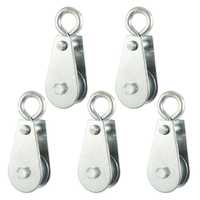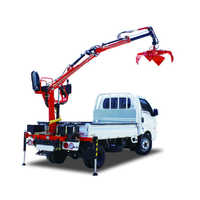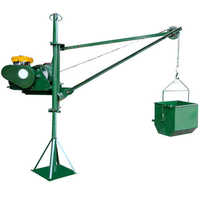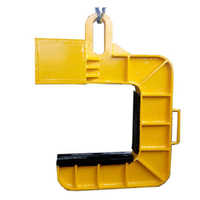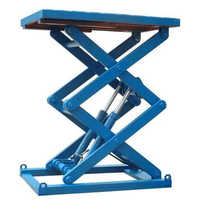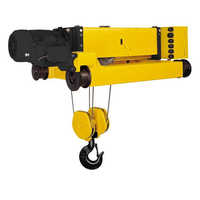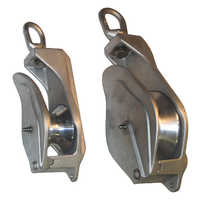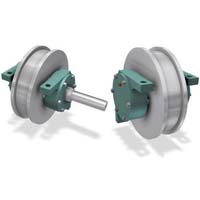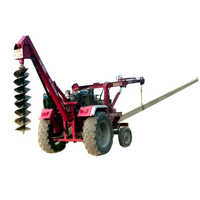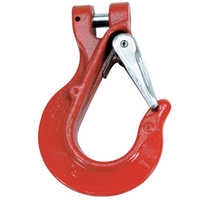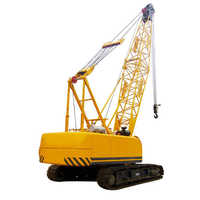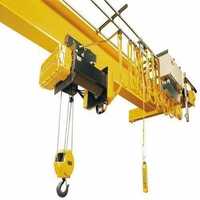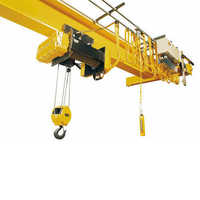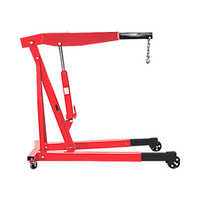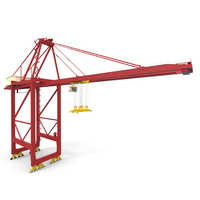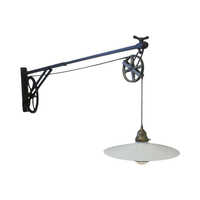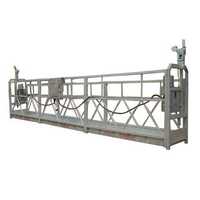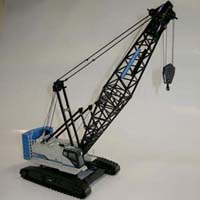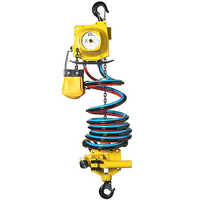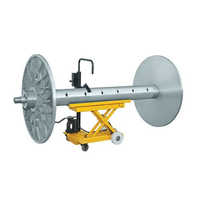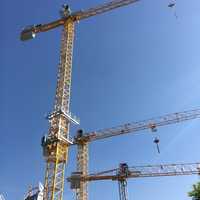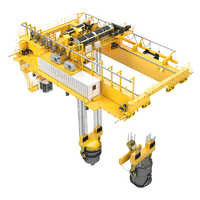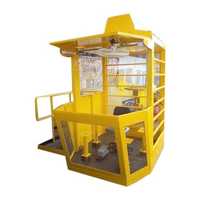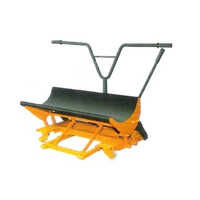Cranes
(9229 products)
Explore More Categories
Made in India
Mobile Crane - Color: Yellow
MOQ - 1 Unit/Units
Color - Yellow
Usage - Industrial, Construction
Product Type - Mobile Crane
9 Years
Business Type: Manufacturer | Supplier
ACTION CONSTRUCTION EQUIPMENT LTD.
Battery Operated Floor Crane - Application: Construction
Price: 345000 INR (Approx.)/Piece
MOQ - 1 Piece/Pieces
Condition - New
Color - Yellow
Size - customized
1 Years
Business Type: Manufacturer | Supplier
VEDANT LIFT
Made in India
Industrial Hot Crane Application: Storage Yard
Price: 3000000 INR (Approx.)/Unit
MOQ - 1 Unit/Units
Condition - New
Application - Construction, Storage Yard, Warehouse, Ship Building
Emergency Stop - Yes
5 Years
Business Type: Manufacturer | Supplier
STARLINE INDUSTRIES
Made in India
Man Left Crane 18.28 M Application: Construction
MOQ - 100 Piece/Pieces
Condition - No
Material - Metal
Application - Construction
4 Years
Business Type: Manufacturer | Distributor
DYNAMIC CRANE ENGINEERS PRIVATE LIMITED
Made in India
Eot Crane Application: Material Yard
Price: 700000 INR (Approx.)/Piece
MOQ - 1 Piece/Pieces
Feature - Hydraulic Crane
Color - Yellow
Product Type - EOT Crane
16 Years
Business Type: Manufacturer | Exporter
AMRATLAL CHHAGANLAL
Made in India
Hard Structure And Rust Proof Double Girder Hot Cranes
Price: 500000 INR (Approx.)/Piece
MOQ - 1 Piece/Pieces
Color - Yellow
Feature - Hydraulic Crane, Jib Crane, Truck Crane, Gantry Crane, Track Crane, Floating Crane
Usage - Moving Goods
17 Years
Business Type: Manufacturer | Exporter
MAX INDUSTRIES
Hot Crane Application: Material Yard
Price: 300000.00 INR (Approx.)/Unit
MOQ - 1 Unit/Units
Condition - New
Feature - Gantry Crane
Color - Red
21 Years
Business Type: Manufacturer | Supplier
SAFEX INDUSTRIES LIMITED
Made in India
High Quality And Rust Proof Construction Crane
Price: 250000 INR (Approx.)/Unit
MOQ - 1 Unit/Units
Condition - New
Product Type - High Quality Construction Crane
Usage - Industrial
18 Years
Business Type: Manufacturer | Exporter
VIKRANT CRANES INDIA PVT.LTD.
Yellow Hydraulic Floor Cranes
Price: 65000 INR (Approx.)/Unit
MOQ - 1 Unit/Units
Usage - Industrial, Construction
Condition - New
Color - Yellow
9 Years
Business Type: Manufacturer | Distributor
SIDDH KRUPA STEEL FAB
Made in India
Golden Yellow 5 Ton Double Girder Eot Crane
Price: 8000000 INR (Approx.)/Piece
MOQ - 1 Piece/Pieces
Product Type - 5 Ton Double Girder Eot Crane
Trolley Travel Speed - 0-5 m/min
Usage - MATERIAL HANDLING
5 Years
Business Type: Manufacturer | Exporter
AARYA ENGINEERING
Jib Crane Application: Construction
Price: 1000000 INR (Approx.)/Pieces
MOQ - 10 Pieces
Condition - New
Feature - Portal Crane
Color - Yellow
5 Years
Business Type: Manufacturer | Supplier
LABH PROJECTS PVT. LTD.
Verified Exporter
( Accepts only Foreign Inquiry)
Made in India
Grove Gmk5100 Telescopic Boom Cranes
Price: 100000 INR (Approx.)/Unit
MOQ - 1 Unit/Units
Usage - Industrial
Product Type - Grove Gmk5100 Telescopic Boom Cranes
Feature - Hydraulic Crane, Jib Crane, Truck Crane, Track Crane
8 Years
Business Type: Service Provider
BHADORIA ENGINEERING SERVICES PVT.LTD
Indian Inquiries Only
Made in India
Workshop Mobile Floor Crane
Price: 85000 INR (Approx.)/Piece
MOQ - 1 Piece/Pieces
Condition - New
Product Type - Workshop Mobile Floor Crane
Height - Upto 20 Feet Foot (ft)
4 Years
Business Type: Manufacturer | Distributor
FORCELIFT MATERIAL MOVEMENTS
Indian Inquiries Only
Strong Flame Proof Electric Wire Rope Hoist
Price: 50000 INR (Approx.)/Unit
MOQ - 1 Unit/Units
Usage - Industrial
Condition - New
Lifting Capacity - 5 Tonne
3 Years
Business Type: Manufacturer | Service Provider
Harikant Engineering Industries
Indian Inquiries Only
Made in India
Yellow Goliath Crane
Price: 1500000 INR (Approx.)/Piece
MOQ - 1 Piece/Pieces
Color - Yellow
Condition - New
Product Type - Goliath Crane
3 Years
Business Type: Manufacturer | Exporter
DERRICK ENGI WORKS PRIVATE LIMITED
Made in India
25 Ton DG EOT Crane
Price: 1400000 INR (Approx.)/Piece
MOQ - 1 Piece/Pieces
4 Years
Business Type: Manufacturer | Service Provider
SHIVAY ENGINEERING WORKS
Made in India
Hydraulic Floor Crane Application: Hydro Power
Price: 44800 INR (Approx.)/Unit
MOQ - 1 Unit/Units
Color - Yellow
Usage - Industrial
Condition - New
8 Years
Business Type: Manufacturer | Exporter
MAHINDRA STILLER AUTO TRUCKS LIMITED
Indian Inquiries Only
Made in India
Mobile Crane - Material: Stainless Steel
Price: 800000 INR (Approx.)/Unit
MOQ - 10 Unit/Units
Usage - Industrial
Condition - New
Material - Stainless Steel
2 Years
Business Type: Supplier | Exporter
SHIVAM CONSTRUCTION COMPANY AND EARTH MOVERS
Made in India
Counter Balance Floor Crane Application: Outdoor Yard
Price: 55000 INR (Approx.)/Piece
MOQ - 1 Piece/Pieces
Feature - Portal Crane
Usage - Industrial
Condition - New
10 Years
Business Type: Manufacturer | Supplier
K Y INDUSTRIES
Electric Jib Cranes Application: Construction
Price: 480000 INR (Approx.)/Piece
MOQ - 1 Piece/Pieces
Condition - New
Material - iron / Steel
Crane Type - Jib
4 Years
Business Type: Exporter
SUNIT CONCRANES PRIVATE LIMITED
Made in India
Iron Eot Crane
Price Trend: 50000.00 - 10000000.00 INR (Approx.)/Unit
MOQ - 5 Unit/Units
Condition - New
Usage - Industrial
Material - Iron
3 Years
Business Type: Manufacturer | Exporter
KESHAV INDUSTRIES
Indian Inquiries Only
Made in India
Crane Wheel Assembly Usage: Industrial
Price Trend: 150000.00 - 1500000.00 INR (Approx.)/Piece
MOQ - 01 Piece/Pieces
Condition - New
Product Type - Crane Wheel Assembly
Usage - industrial
18 Years
Business Type: Manufacturer | Exporter
GANESH ENGINEERING CO.
Made in India
Industrial Under Slung Cranes Application: Construction
Price: 2500000 INR (Approx.)/Unit
MOQ - 10 Unit/Units
Material - Stainless Steel
Application - Construction
Control Type - Cabin
2 Years
Business Type: Manufacturer | Distributor
WSP CRANES & SERVICES
Made in India
Ms End Carriage
Price: 145000 INR (Approx.)/Piece
MOQ - 1 Piece/Pieces
Material - MS
17 Years
Business Type: Manufacturer | Exporter
SILVERLINE METAL ENGINEERING PVT. LTD.
Indian Inquiries Only
Made in India
Industrial Under Slung Cranes Application: Workshop
Price: 100000 INR (Approx.)/Unit
MOQ - 1 Unit/Units
Condition - New
Color - Yellow
Product Type - Industrial Under Slung Cranes
3 Years
Business Type: Manufacturer | Exporter
MALGUDI ASSOCIATES
Yellow 30 Ton Eot Crane
Price: 2500000 INR (Approx.)/Unit
MOQ - 1 Unit/Units
Crane Traveling Speed - 0-5 m/min m/m
Color - Yellow
Condition - New
3 Years
Business Type: Manufacturer | Trading Company
MOX FABRICATORS AND ENGINEERS
Indian Inquiries Only
Made in India
Yellow Balance Crane For Material Handling
Price Trend: 50.00 - 250.00 INR (Approx.)/Piece
MOQ - 100 Piece/Pieces
Weight - 325 Kilograms (kg)
Color - yellow
6 Years
Business Type: Manufacturer | Distributor
VE TO CLAMPING SYSTEMS PRIVATE LIMITED
Heavy Duty And Rust Resistant JIB Crane
Price: 250000 INR (Approx.)/Piece
MOQ - 1 Piece/Pieces
Feature - Hydraulic Crane
Usage - Industrial
Product Type - Cranes
4 Years
Business Type: Manufacturer | Supplier
MP CRANE INDIA
Cranes Manufacturers | Suppliers in India
| Company Name | Location | Member Since |
|---|---|---|
| Safex Industries Limited | Ahmedabad, India | 21 Years |
| Vikrant Cranes India Pvt.Ltd. | Ahmedabad, India | 18 Years |
| Ganesh Engineering Co. | Ahmedabad, India | 18 Years |
| Max Industries | Kapadwanj, India | 17 Years |
| Silverline Metal Engineering Pvt. Ltd. | Mumbai, India | 17 Years |
| Amratlal Chhaganlal | Mumbai, India | 16 Years |
| K Y Industries | Ahmedabad, India | 10 Years |
| Action Construction Equipment Ltd. | Faridabad, India | 9 Years |
| Siddh Krupa Steel Fab | Ahmedabad, India | 9 Years |
| Bhadoria Engineering Services Pvt.Ltd | Bharuch, India | 8 Years |
What Is Crane?
A machine that can raise and carry huge weights, machinery, materials, and goods for a number of purposes is known as a crane. Cranes come in a variety of sizes. They have use in construction, manufacturing, shipbuilding, and the loading of materials, to name a few of the many industries that make use of them.
Cranes are a typical sight along skylines since they are essential to the construction of skyscrapers, which are increasingly widespread in the cities of today.
The Basic Components of the Crane
There are many different kinds of cranes, but there are a few basic parts that you should know about. The most important parts of a crane are.
1. The boom
The crane's boom is instantly recognisable. The boom consists of a long arm that can extend or remain stationary. Depending on the Cranes design, they may be responsible for a wide range of tasks. They function without jibs and are often the primary part of a crane.
2. The Rotex Gear
The Rotex gear can be found beneath the crane's control booth. The cab and the boom can be turned left and right. A seemingly insignificant motion that is crucial to the machine's operation.
3. The Jib
The jib is a lattice-like structure affixed to the end of a crane's boom. By employing a lattice structure, the extra weight is distributed away from the leading edge of the boom. In contrast to a boom, its length is fixed and cannot be altered.
The jib on some mobile cranes is an attachment that can be made to the end of the boom to aid in lifting and moving heavy objects.
4. Counterweights
They are called "counterweights" because their primary function is to balance off the load at the front of the crane when lifting heavy objects to prevent the crane from toppling over. In general, they improve the machine's steadiness and make it more reliable.
5. Outriggers
A crane's outriggers are likely the single most crucial element of safety. Adding extra stability is what an outrigger is there for. A crane needs outriggers to keep it from toppling over by spreading the weight of the structure over a wider base. The load capacity of an outrigger must be equal to or greater than that of the crane or task at hand.
6. The hook
As a last point, the crane needs a means of attaching materials to it. Using a hook is the most common method for accomplishing this. Cranes typically have a safety catch on the lifting hook to keep the load from falling off during transport.
Types Of Cranes Used For Construction & Industrial Projects
Below, we'll take a look at the many kinds of cranes and the work they can do.
i. Carry deck crane
A successor to the pick & carry crane, the crane, was introduced in the 2000s. They're easily transported from one location to another thanks to their compact size, four wheels, and 360-degree rotation. A common sight on many construction sites, carry deck cranes require little in the way of setup time and may readily move between enclosed and open areas.
ii. Truck- mounted crane
Two main components make up a truck-mounted crane: the carrier (the truck itself) and the boom (arm). Because of how they're constructed, they can hit the road with minimal preparation and transit.
Cranes mounted on trucks are able to travel slowly despite carrying a heavy load because they have stabilising features like counterweights and outriggers. There are several variations of the truck-mounted crane that serve specialised purposes. Cranes placed on trucks are often used for bridge inspection and repair.
iii. Rough terrain crane
These cranes are employed for pick-and-carry tasks both on and off-road, as their names suggest. If you're familiar with crawler cranes, you'll recognise the basic design of a rough terrain crane: it has a similar upper structure, but its undercarriage is furnished with four massive rubber tyres, usually with four-wheel drive.
Telescoping booms and outriggers help rough terrain cranes maintain their stability and manoeuvrability in challenging environments.
iv. Floating crane
These cranes are often referred to as crane ships or crane vessels, and they are utilised for undertakings at sea. These cranes have been around since the Middle Ages, and because to constant improvements in technology, they have aided countless generations of people in the years afterwards.
Semi-submersible cranes or Sheer-leg cranes are just two examples of the modern varieties of floating cranes available. To a large extent, the only difference between land-based cranes and floating cranes is where they are used.
v. Crawler crane
Crawlers, as opposed to wheeled carry deck cranes, are tracked vehicles. Crawlers are constructed on an undercarriage that features a set of rubber tracks in place of wheels. As a result, the crawler's turning radius is reduced, but it can now be used on soft ground and sites with minimal improvement without sinking.
Crawler cranes are extremely versatile because of their size-changing telescoping arms, which may be used on a wide variety of surfaces. Crawlers, in contrast to carry decks, are too cumbersome, specialised, and time-consuming to be employed on short-term tasks.
vi. Hammerhead crane
Construction projects frequently make use of hammerhead cranes. This crane utilises a horizontally mounted swivelling lever on a stationary tower. The trolley rests at the tip of the arm's forward section, which is balanced by the arm's rearward extension.
Racking is a function available on hammerhead cranes that allows the trolley to slide forward and backward along the crane arm. These cranes are built from scratch, and their weight and size vary greatly depending on their final configuration.
vii. Telescopic crane
The boom (arm) of telescopic cranes is fitted with a hydraulic cylinder that allows it to extend and retract, just like a telescope. Despite its reputation as a stationary device, telescopic cranes are frequently mobile thanks to their mounting on trucks.
Since telescopic cranes' booms can retract and fold up, they can be used in a wide variety of settings, from temporary construction to rescue operations after natural disasters or other emergencies.
Details About Industrial Cranes And Their Usages
Many variants of industrial cranes can be found for sale today. If you run a factory or a building site, you're responsible for choosing the right crane. A variety of industrial cranes and their respective functions are discussed here.
1. Bridge crane
Bridge cranes are commonly used on building sites. The bridge is the primary distinguishing feature of this crane design. The bridge is equipped with a hoist trolley that shuttles between two permanent runways.
This type of industrial crane is ideal for the routine transportation of massive objects. The hoist trolley can follow the path of the bridge if necessary. If you want to relocate the load, you'll need to secure it to the hoist trolley.
2. Tower crane
When compared to other types of industrial cranes, tower cranes stand out due to their extreme height. Since they are taller than average, these cranes can hoist heavier objects into the air. The business elite simply cannot conceive of erecting skyscrapers, high-rise structures, or retail malls without these cranes.
3. Aerial crane
To move loads or supplies to outlying areas, an aerial crane is an excellent choice. When it comes to accessing all areas, larger vehicles like trucks or cranes simply won't do.
Aerial cranes are useful tools to have in these situations for lifting and shifting heavy objects. For the purpose of fulfilling the tasks at hand, these cranes are affixed to hovering helicopters.
4. Workstation crane
Cranes of the workstation variety are the most practical options for smaller establishments like garage garages and factories. There are several structural similarities between a bridge crane and a workstation crane.
This specific type of crane also features a movable bridge with a restricted working area. A workstation crane is useful for moving tools and other items around an assembly or welding station within a constrained area.
5. Railroad crane
A railroad crane's unique design sets it apart from other types of cranes. The "crane body" of a railroad crane is coupled to the "railroad" itself. Track maintenance and derailment repairs are two of the primary uses for a railroad crane.
During construction, civil engineers make use of a wide variety of cranes. Practically everyone has seen an industrial crane, as they are used to transport huge cargo and equipment to various locations, as well as lift large pipes from one place to another. When constructing structures like buildings and bridges, these are helpful. When it comes to production, these are a must-have. It reduces a monumental task to a breeze.
FAQs: Cranes
Q. What is the difference between mobile crane and crawler crane?
Ans. Cranes that have wheels are usually called "mobile cranes, while cranes that have tracks are often called "crawler cranes.
Q. What does EOT mean in cranes?
Ans. Electric overhead travelling crane, or EOT crane, is one of the most common types of overhead crane.
Q. What is meant by hot cranes?
Ans. Hoist One Track is what HOT Cranes stands for. HOTs are a type of overhead crane that stays in one place and can move laterally in two planes.
Related Categories
Abrasives
Acoustic Products
Acrylic Sheets
Air Blowers
Air Compressors & Air Separation Plants
Air Cooler
Air Dryers
Air Receiver
Air Valves
Aluminum Castings
Anchors
Anti Vibration Mounts
Ball & Roller Bearings
Ball Valves
Ballast Making Machines
Bearing Parts & Components
Bearings
Bellows & Expansion Joints
Belt Pulleys
Boilers, Components & Spares
Bolts
Bright Bars
Bristles
Burners/Industrial Burners & Incinerators
Bushings & Bushing Parts
Butterfly Valves
CNC Machined Components
Cable Pulleys
Capital Goods
Carbon & Graphite Products
Castor Wheels
Centrifugal Pumps
Centrifuges
Ceramics
Chains & Chain Link Fence Fittings
Cleaning Equipment
Clips, Clamps
Coils
Combustion Equipment
Compression Springs
Compressors & Allied Equipment
Control Valves
Conveyor & Conveyor/Industrial Belts
Cooling Tower & Chilling Plants
Corrosion Protection Materials
Coupling
Cranes
Cryogenic Equipment
Cutting Tools, Broaches & Cutters
Departmental Shelving
Diaphragm Valves
Die Castings
Dies & Moulds
Dies,Jigs,Fixtures
Diesel Engine & Electric Locomotive Spares
Draught Fan
EOT Cranes
Electric Hoists
Electric Motors & Engines
Electroplating Chemicals & Equipment
Elevators, Lifts & Escalators
Energy Management System
Engine Valves
Engineering Goods & Equipment
Engineering Plastics
Engraving Equipment
Extruded Profiles
Fasteners
Fiberglass Products
Filter Cartridges & Media
Filter Cloth, Filter Industrial
Filters-Air, Gas, Liquid
Filtration & Sedimentation Units
Flat Metal Processing Equipment
Float Valves
Fork Lift Truck Parts
Fork Lift Trucks
Forklifts
Foundry Raw Material & Equipment
Furnace Manufacturers
Galvanized Fasteners
Gantry Cranes
Gaskets
Gate Valves
Gauges & Gauge Glasses
Gear Boxes, Reduction Gears & Gear Cutting
Girder Cranes
Glass & Glass Products
Glass Cutting Tools/Glass Cutters
Globe Valves
Goliath Cranes
Grating
Hand & Allied Tools
Hand Pump
Hardware & Tools
Heat Exchangers
Heating Elements
Hex Bolts
Hex Nuts
Hooks & Mounts
Hoses
Hot Air Oven
Humidification & Ventilation Equipment
Hydraulic Hoses & Flexible Metal
Hydraulic Press
Hydraulic Press Brakes
Hydraulic Products & Equipment
Hydraulic Valves
Induction Heating Equipment
Industrial Automation
Industrial Brakes
Industrial Brushes
Industrial Clothing
Industrial Clutches
Industrial Cylinders
Industrial Dryers
Industrial Evaporators
Industrial Knives
Industrial Nets
Industrial Ovens
Industrial Rollers
Industrial Supplies Stocks
Industrial Supplies-General
Industrial Tape
Industrial Tools
Industrial Valves
Industrial Vibrator
Inspection Equipment
Instrumentation
Internal Combustion Engine
Jib Cranes
Laboratory Furniture
Laboratory Glassware & Equipment
Laundry Equipment
Lined Valves
Machine Tools Accessories
Marking Systems
Material Handling Equipment
Measuring Tools & Equipment
Mechanical Seals
Metallised Capacitor Films
Mining Equipment
Mining, Exploration & Drilling Machinery
Model Making Materials
Motor Couplings
Moulded Components
Moulds
Needle Valves
Needles
Nuts
Oil Seals
Outdoor Cooling Systems
Overhead Cranes
PVC Hoses
PVC Products
Paint Brushes
Painting Equipments & Maintenance
Perforated Sheets
Plastic Processing Machinery Parts
Plastic Valves
Plastic Welding Equipment
Plate Valves
Plug Valves
Pneumatic Products & Tools
Pneumatic Valves
Polish & Polishing Material/Machinery
Power Press
Precision Brass Components
Pressed Components
Pressure Gauges
Pressure Vessels
Pulleys
Pulverizers
Pump Spares Parts
Pumps & Pumping Equipment
Radiators
Refrigeration & Equipment
Rope Pulleys
Rope,Twines & Webbings
Ropes
Rotary Valves
Rubber & Rubber Products
Rubber Gaskets
Rubber Roller
Rubber Seals
Rubber Transmission Belts
Screws
Seals
Sensors & Transducers
Shaft Couplings
Shafts & Shaft Collars
Sheet Metal Components & Parts
Solenoid Valves
Springs
Stainless Steel Bolts
Stainless Steel Fasteners
Stainless Steel Nuts
Stainless Steel Valves
Storage Systems
Storage Tanks
Submersible Pumps
Surface Finishing Equipment
Synthetic Industrial Diamonds
Testing & Measuring Equipment
Thermostatic Bimetals & Thermostats
Trolleys & Carts
Tungsten Carbide
Ultrasonic Equipment
V-Belts
Vacuum Equipment & System
Valves
Valves Fittings
Vibrating Screen
Washers
Water Coolers
Weighbridge
Welding & Soldering Supplies
Welding Electrodes
Welding Equipment
Winches
Wire Drawing Dies
Wire Rope Hoists
Wire Ropes
